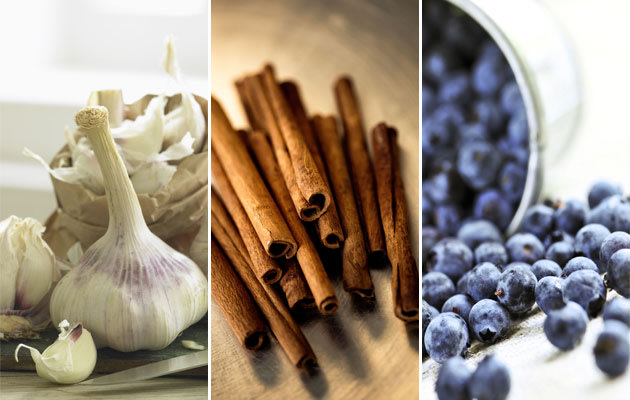
The good news is however, that just by adding these simple, bug busting foods to your daily diet you can stack the odds in favour of becoming the ultimate flu fighter and build an immune system with truly super human strength ……
1. Cinnamon
Packed full of disease preventing, immune boosting nutrients, just one teaspoon of ground cinnamon has the same amount of antioxidants as a serving of fresh blueberries. As if that wasn’t enough, research shows that adding ground cinnamon to fruit and vegetables can actually enhance the uptake of antioxidants from foods too. Cinnamon also has antifungal and antibacterial properties which help to fight infection.
How to add it to your diet:
Just one teaspoon of cinnamon a day is all that’s needed to boost your immune system so sprinkle over fresh or tinned fruit, add to curries, smoothies and cake and biscuit mixes or stir into to your morning muesli or porridge. Cinnamon sprinkled over melon also adds a delicious twist or alternatively add it to green or herbal teas.
2. Live yogurt
According to a study at the University of Vienna people who ate live yogurt daily for just 14 days raised their killer T cell count by almost 30%. Why? Live yogurt contains ‘friendly’ bacteria which help to strengthen the body’s natural defences making it far better at warding off potential bugs and viruses.
How to add it to your diet:
Use it to make smoothies and dips, add a spoonful to breakfast cereals and deserts, stir into soups, curries and sauces or eat it topped with plenty of fresh fruit and berries,
3. Garlic and onions
Both garlic and onions contain a compound called allicin which, thanks to its antiviral properties is an extremely powerful flu fighter. So much so in fact, UK researchers concluded that people who took allicin supplements as part of their study not only caught 46 percent fewer colds, they also recovered faster from the colds that they did get.
[See also: Vitamin supplements - essential for health or a waste of money]
How to add them to your diet:
Sprinkle very finely chopped spring onions over chillies, risottos and wraps. Add red or Spanish onions to salads, sandwiches and stir fries. Red onions may be particularly beneficial as they contain quercetin which, so far, has been shown to reduce the likelihood of developing colds and flu.
For a really delicious side to almost any meal finely slice a combination of large white Spanish onions and red onions, place in a roasting tray, drizzle with a little balsamic vinegar and oil and sprinkle over a couple of teaspoons of sugar. Stir lightly then roast in a medium to hot oven for 30 — 40 minutes until caramelized and golden. Serve as a side dish to steak or chops or as a delicious base to a lightly grilled fillet of white fish.
Try roasting a whole garlic head too. Simply slice off the top third so that the cloves are exposed, drizzle with a little oil then place on an oven proof dish, cover with foil and bake in a hot oven for 30 — 40 minutes until the garlic is soft and golden brown. Once cooled, squeeze the garlic from the cloves and spread on warm bread, stir into soups or mix into hot pasta.
4. Blueberries
These little beauties are not only packed with immune boosting, germ busting vitamin C they also have really high concentrations of antioxidants. So much so in fact that when tested they were found to have, gram for gram, considerably more antioxidants than over forty other fruits and vegetables.
How to add them to your diet:
Eat at least a cupped handful a day and if you can’t find fresh blueberries try frozen instead. They are available in most good supermarkets and make a great, ready chilled addition to a smoothie. Alternatively, simply pop the frozen berries in a sieve and run them under cold water for a couple of minutes to defrost before adding them to cereals, deserts, pancakes and yogurts.
5. Mackerel
Mackerel is not only a good source of Vitamin D it is also a great source of omega three fatty acids, both of which play an essential role in keeping your immune system in tip top condition. In fact, according to recent US study, participants with low levels of vitamin D were approximately 40 percent more likely to have suffered from a recent respiratory infection than those with higher levels of vitamin D.
Salmon is also a good source of both nutrients but vitamin D levels can vary a great deal depending on whether it is wild or farmed. Mackerel however is far cheaper and a more sustainable option. Aim to eat it at least twice a week.
How to add it into your diet:
Whether fresh or tinned you’ll still get all the vitamin D and essential fatty acids you need so try adding both into your diet. Tinned, peppered mackerel is delicious added to savoury rice, salads or fish pies and chilled, smoked mackerel fillets make a great, super quick meal added to hot pasta or served alongside some steaming, new potatoes, broccoli or lightly sautéed spring cabbage.
For a truly irresistible dip add a fillet of smoked mackerel to a food processor with a generous squeeze of lemon juice, a couple of spring onions, some low fat yogurt and plenty of black pepper. Whizz for a few seconds until a creamy paste and serve as a dip with crudités or a filling for hot whole meal pitas. Fresh mackerel fillets can be bought from any good supermarket or fishmongers and take just a few minutes to grill. Serve with mashed potato creamed with a little horseradish and plenty of fresh vegetables.
refers: http://uk.lifestyle.yahoo.com/blogs/rachael-anne-hill/five-fantastic-flu-fighting-foods-163502085.html
